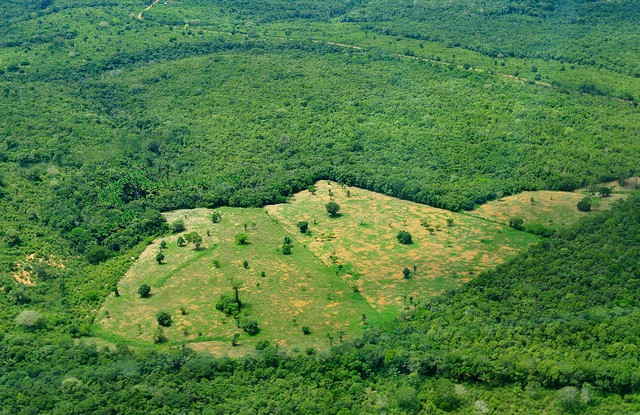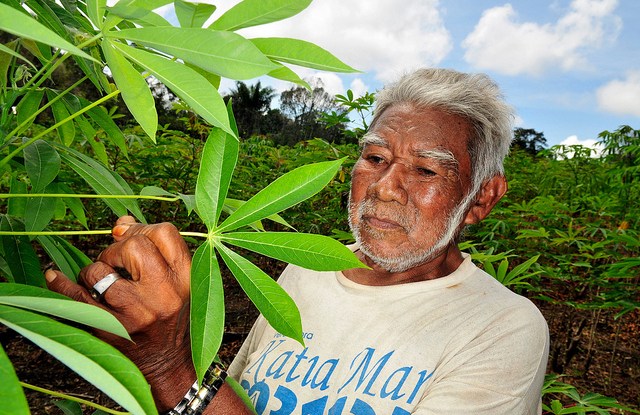
BOGOR, Indonesia—In the world of forest law enforcement, it was hailed as a historic breakthrough.
Brazil’s arrest in February of Ezequiel Antonio Castanha, accused of leading a forest-clearing syndicate from the Amazonian city of Novo Progresso, could signal a renewed crackdown on deforestation, which despite major reductions in the past decade has risen of late and has even in its impacts been linked to the worst drought in the country’s history.
The operation against Castanha—dubbed the “King of Deforestation” in local media—had an almost instantaneous effect, with forest-clearing rates in some areas of Brazil dropping by 65 percent, according to the country’s environment ministry.
For every “king,” however, there is an army of less-nefarious smallholders eking out a living in remote forests where the long arm of the law strains to reach. In these cases, incentive “carrots” may also be needed to complement the enforcement “sticks” of land-use policies in order to balance costs, benefits and social equity, according to a new study by the Center for International Forestry Research (CIFOR).
Introducing more carrots to the policy recipe, researchers say, will require some tradeoffs in a system that so far has relied more heavily on the stick.
“Part of the reason Brazil has relied so much on ‘sticks’ so far is that the laws are already in place, so essentially they just had to enforce existing laws to bring about this change,” said study co-author Jan Börner of the University of Bonn’s Center for Development Research and an associate researcher with CIFOR.
CIFOR’s research builds on two earlier studies by the same authors: The first mapped opportunity costs in the Amazon and calculated how much of a financial incentive was needed through a payment-for-ecosystem services (PES) scheme to essentially buy out deforestation; the second analyzed the effectiveness of command-and-control measures.
“Now we are trying to put the two together, and I would say looking at these policy mixes has become a field of growing interest in the international community,” said CIFOR principal scientist Sven Wunder, another co-author of the study.
“As academics we tend to analyze policy instruments in isolation, because that allows us to look at the partial effect that instrument has. But in reality, we see a mix of policies or interventions being applied, and actually their joint effect may be a different sum of partial effects.”
‘STICKS’ EFFECTIVE, BUT AT GREAT COST
The researchers used spatial models for deforestation decisions in response to policy incentives and disincentives in the Brazilian Amazon—and confirmed that policy-makers will face difficult tradeoffs in aligning PES incentives with disincentives in order to make conservation socially acceptable and cost-effective.
On a purely monetary basis of government spending, the most cost-effective mix is dominated by command-and-control measures, with more than 30 hectares of forest conserved per each R$1,000 (1,000 Brazilian reais, the equivalent of about USD345) that is invested in the policy.
This type of policy could achieve conservation gains at enforcement costs of only R$0.03 (less than one US cent) per hectare of forest conserved. However, the opportunity costs borne by land users in this scenario would be large. For the reduction in deforestation that occurred between 2004 and 2012, it could have exceeded R$2 billion (about USD700 million) annually.
It is a hot topic in the political scene in Brazil at the moment, and is a sign that the government is open to solutions that would complement command and control
Carrots without sticks, meanwhile, reduce cost-effectiveness by more than 98 percent, the study found—though carrots helped to ensure a more equal sharing of costs and benefits, thus making conservation politically more palatable.
“The rationale is that you compensate land users for at least some of the losses that occur when they increase their compliance with the law. But of course, that comes at a significant cost to the state, which has to provide a larger budget,” Börner said.
Many of the costs involved in ramping up improved policy mixes could be largely covered with improved law enforcement: The collection of environmental fines is currently extremely low in Brazil and generates little revenue, the researchers say.
FAR FROM THE LAW
A new policy mix can also boost fairness for land users in different parts of the Brazilian Amazon. Land users in far-flung areas can be disproportionally rewarded by PES schemes, as they tend to face a smaller chance of legal scrutiny by dint of their inaccessibility.
But land users with higher opportunity costs—i.e., those closer to roads or rivers—are subject to more regular monitoring and would be hit disproportionally hard by the command-and-control disincentive, despite still being partially compensated through PES.
“This presents a cost problem, which is driven by distance,” Börner said. “As an enforcer, there are places you can have a base station and then you have to go by car, boat or even helicopter to go to the remote places where deforestation takes place. The probability of being fined reduces the farther away you are from cities, roads and rivers—but it increases the more you deforest.”
The government has done well to not hit smallholders too hard, says study co-author Eduardo Marinho, a post-doctoral fellow with CIFOR. For example, it has pardoned smallholders’ past sins of excessive deforestation, and focuses more on largeholders. Brazil is currently setting up an experimental system of tradable development rights, establishing a market for surplus forest so those who have more forest than the law requires can sell their surplus to those who do not have enough.
“This is part of a policy mix we are thinking of exploring in the future. It is a hot topic in the political scene in Brazil at the moment, and is a sign that the government is open to solutions that would complement command and control,” Marinho said.
For more information about the topics of this research, please contact Sven Wunder at s.wunder@cgiar.org or Jan Börner at jborner@uni-bonn.de.
This research was supported by the Robert Bosch Foundation, European Commission and the CGIAR Research Program on Forests, Trees and Agroforestry.
We want you to share Forests News content, which is licensed under Creative Commons Attribution-NonCommercial-ShareAlike 4.0 International (CC BY-NC-SA 4.0). This means you are free to redistribute our material for non-commercial purposes. All we ask is that you give Forests News appropriate credit and link to the original Forests News content, indicate if changes were made, and distribute your contributions under the same Creative Commons license. You must notify Forests News if you repost, reprint or reuse our materials by contacting forestsnews@cifor-icraf.org.
Further reading
The science is clear: Forest loss behind Brazil’s drought
Direct conservation payments in the Brazilian Amazon: Scope and equity implications
Forest law enforcement in the Brazilian Amazon: Costs and income effects
Carrots or sticks? Balancing cost-effectiveness, equity in Brazil’s deforestation policy

